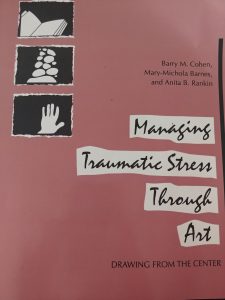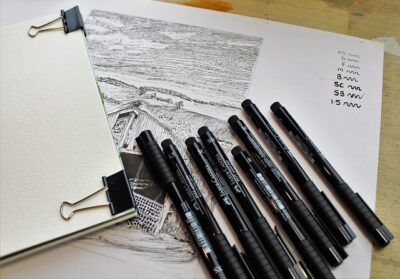 Have you ever experienced those therapy sessions where one simple phrase or question seems to blast a door wide open into the possibilities of individualized treatment that might actually work? Well, it was not my own session that accomplished this. It was my husband’s session when he told our therapist that I like to doodle and be creative and my therapist had an idea that changed everything for me in terms of personal growth and development. My therapist gave me a means of expression and processing that I had given up hope for through a book by entitled Managing Traumatic Stress Through Art, by Barry M. Cohen, Mary-Michola Barnes, and Anita B. Rankin.
Have you ever experienced those therapy sessions where one simple phrase or question seems to blast a door wide open into the possibilities of individualized treatment that might actually work? Well, it was not my own session that accomplished this. It was my husband’s session when he told our therapist that I like to doodle and be creative and my therapist had an idea that changed everything for me in terms of personal growth and development. My therapist gave me a means of expression and processing that I had given up hope for through a book by entitled Managing Traumatic Stress Through Art, by Barry M. Cohen, Mary-Michola Barnes, and Anita B. Rankin.
The book begins by explaining how a group of doctors came up with methods to safely work through trauma at home, though still under the care of a licensed physician. The best part is that these exercises DO NOT require any level of skill or expertise in art. Whether one can paint beautiful murals or is struggling with oddly constructed stick-figures, which is pretty much where I was before this book, is insignificant to completing the exercises. No skill level is required. Fascinatingly, within the introduction, the authors state how even the “medium” or tools used for producing art can aide in expression or hinder the process through re-traumatization. For people with anxiety, like myself, a lead pencil involves a level of resistance while paint may be too free-flowing. For intense emotions, using something with a greater resistance is particularly helpful, rather than a medium that just allows the emotions to out-pour without any form of control. I have found that I personally prefer oil-pastels and lead pencils.
There are three sections: (1) Developing Basic Tools for Managing Distress, (2) Managing Emotions and (3) Existing in the World. The authors recommend completing the first section in order, and then the other two sections can be completed in any order and can even be repeated because thought processes and circumstances can change over time. Each exercise includes an introduction to the topic, a list of required materials, questions for getting started, clear directions on how to complete the exercise, and questions for thought and analysis. The first section of this book has given me a list of tools I can use when the anxiety or depression hits (something I have craved desperately for a long time), and the other exercises have opened the door for many discussions in therapy.
Below is a list of exercises included in the art therapy book. I may never get through all of them, but for the ones I finish, links will be available below after completion:
Section 1: Developing Basic Tools for Managing Distress
- Establishing a Safe Place
- Drawing a Breath
- Protective Container
- Sensory Relief
- Support Net
- Comfort Box
- Paving the Way
- Getaway Guidebook
- Anatomy of Self-Care
Section 2: Acknowledging and Regulating Your Emotions
- Landscapes of Emotion
- Part One: Familiar Terrain
- Part Two: Changing Your Scenery
- Modifying Emotional Patterns
- Layered Feelings
- Mixture of Opposites
- Validating Anger
- Imprint of Fear
- Shame and Guilt
- Lost and Found
- Heart and Mind
Section 3: Being and Functioning in the World
- Self-Image
- Role Quilt
- Life Skills
- Part One: Barely Coping Mechanisms
- Part Two: A Well-Oiled Machine
- Environmental Protection
- Part One: Standing in the Present
- Part Two: Stepping into the Future
- Interpersonal Boundaries
- Part One: Barriers and Broken Boundaries
- Part Two: Building Better Boundaries
- Your Level Best
- Relationships
- Part One: Missed Connections
- Part Two: Within Your Grasp
- Worldview
- Part One: Two Different Worlds
- Part Two: Global Revision
********
Shop at our Amazon store! As an Amazon Influencer, this website earns from qualifying purchases.

